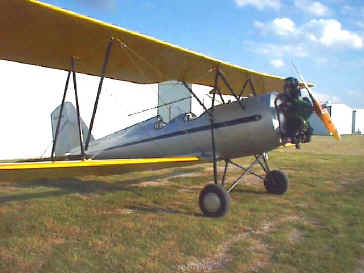|

This 1941 Meyers OTW,
N34310, is operated by the
Pioneer Flight Museum, Kingsbury, Texas.
History: Born in Allenhurst,
New Jersey, in 1908, the son of Swiss immigrants, Allen H. Meyers grew up on a farm in
upper New York State. The fact that his father was a graduate of ETH, the Swiss
equivalent, perhaps, of MIT, influenced Meyers' development. Growing up with ready access
to his father's engineering notebooks and drawings, and the fact that their farm lay
beneath one of the early flyways used by pioneering aviators, Meyers was infused with a
lifelong dedication to aviation and aircraft design.
When, in the mid-1920's, he experienced flight for the first time, his fate was sealed.
After graduating from high school he sought, in vain, for a college curriculum in
aviation. The field was too new for a curriculum to have been developed, so he embarked on
a learning experience of his own making, apprenticing with such early aircraft
manufacturers as Chance Vought, Glenn Martin of Baltimore, and Stinson Aircraft
Corporation of Wayne, Michigan, beginning as a "tin smith" working in aircraft
metal. During that time, he learned to fly, earned his private pilot's license, and
purchased a WACO-10 (OX-5), with which he instructed, flew cross country during an era of
few navigational aids and limited facilities, barnstormed, and began to imagine a better
aircraft design. During 1933-34, he began to polish the design concept for his first plane
later to be called the OTW ("Out to Win").
While working for Stinson Aircraft as a sheet metal worker, he read everything he could
find about aircraft design, studied engineering and mathematics in night school, and began
building the fuselage of his plane in a small garage in Wayne, Michigan.
The first test flight, on 10 May 1936, made headlines in the Detroit News when, after nine
hours of testing, Meyers flew the plane to Middleburg, New York, upon learning that his
mother had been severely burned in a fire. The plane and Mrs. Meyers fared well. That
aircraft, the Meyers OTW, a two-place, tandem-seat biplane, featured an all-aluminum,
oval-shaped, monocoque fuselage (wherein the surface metal is a major structural
component), with abundant strengthening bulkheads, aluminum tail surfaces, and a wide
landing gear with long struts that seems to anticipate the landing gear of the postwar
Cessna in its effect.
Early models of the OTW were powered by 125-hp (OTW-125) or
145-hp Warner "Scarab" (OTW-145) engines, with the
later models powered by 160-hp Kinner R5 engines (OTW-160).
Most of the 102 OTWs manufactured in the Meyers' Tecumseh, Michigan, plant, were used as
primary trainers during World War II, one of two planes later approved for aerobatic
training use in the armed services, where it earned a reputation for being an excellent
aerobatic machine.
With at least 25 OTWs restored and flying, and with all three types represented in that
number, the OTW may very well be a phenomenon among warbirds, with nearly one quarter of
the total manufactured still in use.
Nicknames: Old Time Wreck,
Out to Win.
Specifications (OTW 160):
Engine: One 160-hp Kinner R5 five-cylinder radial piston engine
Weight: Empty 1,325 lbs., Max Takeoff
1,910 lbs.
Wing Span: 18ft. 4in.
Length: 22ft. 6in.
Height: 8ft. 6in.
Performance:
Maximum Speed:
120 mph
Ceiling: 15,500
ft.
Range: 280 miles
Armament: None
Number Built: 102
Number Still Airworthy: 25+
 [
Meyers
OTW Pilot Report by Budd Davisson ]
[
Meyers
OTW Pilot Report by Budd Davisson ]
Links:
Lubbock, Texas
newspaper article on Texas Air Museum OTW
Pioneer Flight Museum -- Meyers OTW page
Russell-Aire Meyers OTW site
-- Includes information for owners.

[Back to Warbird Alley's Main
Page]
All text and photos Copyright 2016 The
Doublestar Group, unless otherwise noted.
You may use this page for your own, non-commercial reference purposes only.
 |